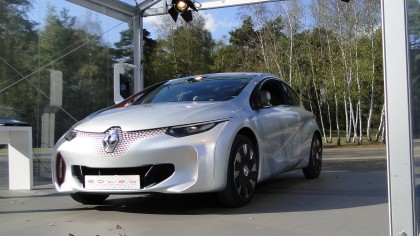The way we measure car efficiency is broken and it's got to change
Europe's NEDC test cyle is dumb as a brick and making cars less efficient, not more efficient

The way fuel consumption and emissions from passenger cars is tested in Europe is idiotic and it's simply got to change.
This isn't exactly breaking news. But with every passing day the EU's NEDC test cycle or New European Driving Cycle looks more and more ludicrous.
The absolute tipping point for me is Renault's clever new Eolab prototype. It's clever in the sense that it absolutely sets out to game the silly NEDC cycle and it does that so brilliantly the result is a preposterous 282mpg.
Not preposterous because it's unlikely to be true. Granted it's just a claim, not an independently verified fact. But there's not reason to believe it's not true.
The reason why it's probably true is because the NEDC cycle is so dumb, it allows any hybrid car with a big battery and plug-in charging capability to look brilliantly efficient compared to a conventional car.
Game theory
The test is so poorly conceived, it can make hybrids that are actually less efficient than conventional cars seem several times more efficient. In other words, there's a good chance the NEDC test is beginning to push car manufacturers to make less efficient, not more efficient cars.
Renault's Eolab is a perfect example. Thanks to some really outstanding work by Renault bringing weight down, the Eolab would be an incredible 400kg lighter than an equivalent hatchback were it powered by a conventional combustion engine. It would also be roughly (and genuinely) 50 per cent more efficient.
Sign up for breaking news, reviews, opinion, top tech deals, and more.

However, because of the way the cars are currently tested, it made sense for Renault to lumber the Eolab with over 150kg of electric motor and lithium battery pack. The reason is that the NEDC test doesn't take into account the energy used to charge the battery.
Plug-in hybrid cars can start the test with a full battery and that energy isn't taken into account. Only the liquid fuel burned is measured. So even a very inefficient combustion car can be made to look like a fuel sipper.
The problem, of course, is that if you're charging that battery off the grid in most developed countries, you're charging it with energy at least partially and probably predominantly produced courtesy of burning stuff.
Low-carbon cop-out
Thus Porsche's 918 Spyder supercar is rated at 94mpg and 70g/km, which makes it sound wonderfully efficient and low-carbon and all that guff. But the reality is that's it's much heavier than it would have been without the huge battery required to game the NEDC test.
What the 918 Spyder's true emissions would be without several hundred kilos of hybrid tat is impossible to say for sure. But given how much energy is required to accelerate the additional mass, there's a chance they would actually be better.

Probably the most efficient solution in the real world would be a mild hybrid with a small battery to allow for some brake energy recuperation. But for Renault and Porsche, NEDC test cycle and in turn legislation across Europe that depends on it forces them to go down this plug-in hybrid path.
But anyway, at this point the traditional riposte to all this is that plug-in hybrids allow for some usable range in pure-electric mode, thus creating the possibility of zero local emissions which is a good thing even if the reality is that there are indirect emissions being released somewhere else in the energy chain.
And that's true. But the thing is, emissions from modern, catalysed petrol engines (so long as they are not direct injection, but that's an argument for another day) are actually very clean. It's not absolutely ideal having any combustion cars running in city centres. But roads full of good catalsyed petrol engine represent a very minimal health hazard.
Not hating on hybrids
To be clear, I'm absolutely not anti hybrid cars. Mild hybrids are very likely the best medium-term bet for long-distance passenger car travel. What I am is against a dated, ill-conceived test cycle that is perverting the direction of car development.
Currently, a new international test cycle is being developed by Europe, Japan and India, the Worldwide harmonized Light vehicles Test Procedures or WLTP. Due in 2015, it hasn't been finalised and I'm not clear on how it treats plug-in hybrids.
But if it's going to have any value in terms of both reducing actual emissions and encouraging car makers to build vehicles that are actually more efficient, not just better at gaming the cycle, then here's hoping the same mistakes aren't being made all over again.
Technology and cars. Increasingly the twain shall meet. Which is handy, because Jeremy (Twitter) is addicted to both. Long-time tech journalist, former editor of iCar magazine and incumbent car guru for T3 magazine, Jeremy reckons in-car technology is about to go thermonuclear. No, not exploding cars. That would be silly. And dangerous. But rather an explosive period of unprecedented innovation. Enjoy the ride.